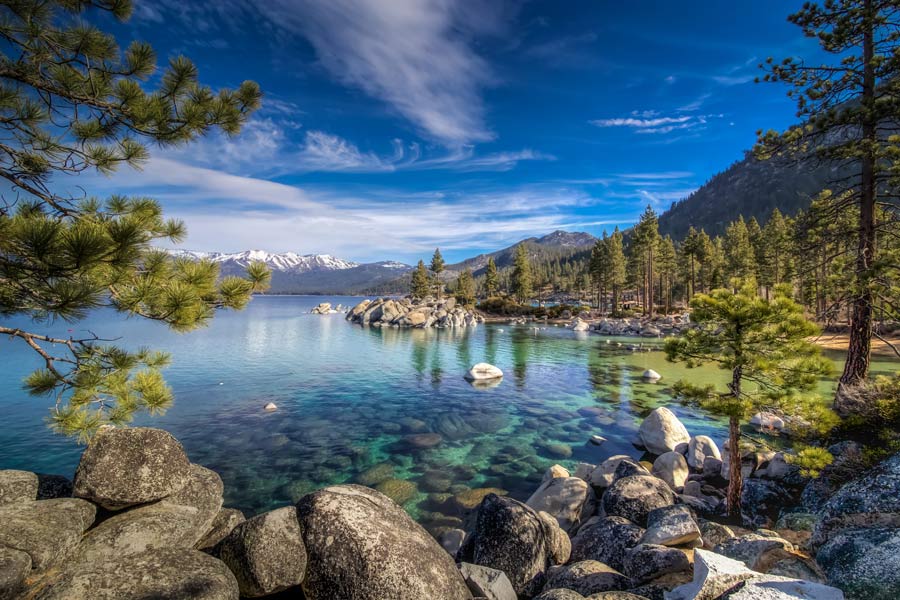Vail Resorts reports skiers visits are down by nearly 8%
The news came as a disappointment to investors
Vail Daily

Mike Peron / Tahoe Daily Tribune
Vail Resorts gave investors a late-season earnings update on Friday, saying season-to-date skier visits were down 7.8% compared to the prior year while lift revenue was up 3.2%.
The increased lift revenue, which accounts for an allocated portion of season pass revenue, was one of several key performance indicators that were up during the year. Others included ski school revenue, which is up 7% season to date, and dining revenue, which increased 2.4% compared to the prior year.
But despite the increases in those key performance indicators, the company said earnings are likely to be at the low end of the guidance the company has previously issued, guidance which had already been lowered from a prior prediction that was again at the low end of a previous forecast.
The news came as a disappointment to investors.
Truist Securities is one of 10 firms that has an equity analyst assigned to cover Vail Resorts.
In a note issued Friday, Patrick Scholes with Truist Securities wrote: “One of the biggest pushbacks we receive from investors on this company is the repetitive guide-downs and the company’s (in)ability to hit its forecasts. Unfortunately, today’s announcement does nothing to alleviate that concern and only worsens it.”
In Friday’s news release, Vail Resorts CEO Kirsten Lynch said the company saw unfavorable conditions across its North American resorts for a large portion of the season.
That wasn’t the case in Vail, which recorded snow every day from January 5-19, contributing to what COO Beth Howard called “an exceptional winter” in February. Vail will end its season on Sunday with a cumulative 306 inches of snow (if no more snow is recorded), one of only four years to see more than 300 inches since 2014-15, according to Vail’s mid-mountain snow stake.
Poor performance at Whistler Blackcomb in March and April was a primary driver of the low earnings forecast, Lynch said.
In issuing Vail Resorts’ previous guidance in March, Lynch said challenging conditions had persisted until early March at Whistler Blackcomb as well as the company’s Tahoe-area resorts. The company was hoping to see guests return in big numbers to both Tahoe and Whistler, but that only happened at Tahoe.
“When conditions improved, visitation at our Tahoe resorts responded as expected, however visitation at Whistler Blackcomb remained below expectations,” Lynch said in Friday’s release.
But the company had sold an estimated 2.4 million pre-purchased passes heading into the 2023-24 season, which helped keep lift revenue high despite lowered visitation. The 2023-24 pass sales were 4% higher than 2022-23, which was 6% higher than 2021-22.
“Our strong season pass sales results, prior to the start of this season, greatly mitigated the impact of the unfavorable conditions that existed across our North American resorts for a large portion of the season, highlighting the stability created by our advance commitment strategy,” Lynch said.
Last season saw consistent storms, cold temps, and record-breaking snowfall across the Western United States, and in the East, while the season was slow to start, snow returned in the late season, helping to contribute to new highs in visitation at some east coast ski areas. Vail Resorts reported record visitation at its ski resorts during March and April of 2023. All of that contributed to record-high skier numbers for North America in 2022-23.
This season, March and April visitation across Vail Resorts’ western North American resorts exceeded the record levels from last year.
Lynch said the results throughout the 2023-24 North American ski season “demonstrate the resiliency of our strategic business model and our network of resorts and loyal guests.”
Turning to next season, Lynch said the company has seen “a modest decline” in pass product units and growth in sales dollars.
Scholes, on Friday, said the slow start to the 2024-25 pass sales season is not encouraging and suggested Vail Resorts should lower its optimism when it comes to forecasting profits.
“As we have called out on earnings calls, we again reiterate that the company take a conservative stance in its guidance to lessen the possibility of more disappointing press releases such as today’s,” he said.
This story is from VailDaily.com. Vail Resorts reports skiers visits are down by nearly 8%

Support Local Journalism

Support Local Journalism
Readers around the Lake Tahoe Basin and beyond make the Tahoe Tribune's work possible. Your financial contribution supports our efforts to deliver quality, locally relevant journalism.
Now more than ever, your support is critical to help us keep our community informed about the evolving coronavirus pandemic and the impact it is having locally. Every contribution, however large or small, will make a difference.
Your donation will help us continue to cover COVID-19 and our other vital local news.








